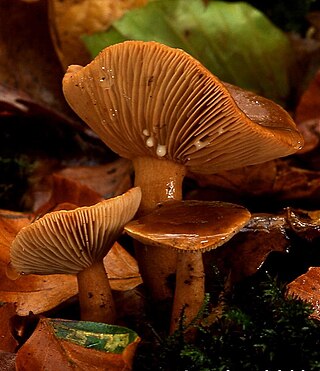
In mycology, a lamella, or gill, is a papery hymenophore rib under the cap of some mushroom species, most often agarics. The gills are used by the mushrooms as a means of spore dispersal, and are important for species identification. The attachment of the gills to the stem is classified based on the shape of the gills when viewed from the side, while color, crowding and the shape of individual gills can also be important features. Additionally, gills can have distinctive microscopic or macroscopic features. For instance, Lactarius species typically seep latex from their gills.

Enrofloxacin, sold under the brand name Baytril, among others, is a fluoroquinolone antibiotic used for the treatment of animals. It is a bactericidal agent.
Gloeophyllum mexicanum is a plant pathogen.

Gloeophyllum sepiarium, the rusty gilled polypore, is a wood decay fungus that causes a brown rot. Gloeophyllum sepiarium grows in thin, dark brown/green brackets on dead conifers. Often found on wood in lumberyards, the fruiting body grows for only one year, and produces spores in late summer and autumn. Its hymenial surface is distinctive from other polypores due to the presence of gills. Gloeophyllum sepiarium is inedible.
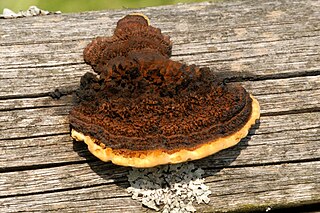
Gloeophyllum trabeum is a species of fungus in the family Gloeophyllaceae.

Heliocybe is an agaric genus closely allied to Neolentinus and the bracket fungus, Gloeophyllum, all of which cause brown rot of wood. Heliocybe sulcata, the type and sole species, is characterized by thumb-sized, tough, revivable, often dried, mushroom fruitbodies, with a tanned symmetric pileus that is radially cracked into a cartoon sun-like pattern of arranged scales and ridges, distant serrated lamellae, and a scaly central stipe. Microscopically it differs from Neolentinus by the absence of clamp connections. Like Neolentinus, it produces abundant, conspicuous pleurocystidia. Heliocybe sulcata typically fruits on decorticated, sun-dried and cracked wood, such as fence posts and rails, vineyard trellises in Europe, branches in slash areas, and semi-arid areas such on sagebrush or on naio branches in rain shadow areas of Hawaii, or in open pine forests.

Gloeophyllum is a genus of fungus in the class Agaricomycetes. It is characterized by the production of leathery to corky tough, brown, shaggy-topped, revivable fruitbodies lacking a stipe and with a lamellate to daedaleoid or poroid fertile hymenial surfaces. The hyphal system is dimitic to trimitic. The genus is further characterized by the production of a brown rot of wood. Phylogenetically, it along with several other brown rot Basidiomycota, Neolentinus, Heliocybe, and Veluticeps form an order called the Gloeophyllales.
Veluticeps is a small genus of wood-rot fungi characterized by the production of resupinate to bracket shaped, perennial, tough, brown fruitbodies, that blacken when KOH solution is applied, and with a smooth to warted or cracked fertile undersurface. They cause a brown rot of wood. Cystidia in the hymenium are characteristically mostly in fascicles. The genus may be monotypic if Columnocystis is excluded. Phylogenetically, the type species, V. berkeleyi, groups with several other brown rot genera such as Neolentinus, Heliocybe, and Gloeophyllum.

Cerithium is a genus of small to medium-sized sea snails, marine gastropod molluscs in the family Cerithiidae, the ceriths.

Plectania is a genus of fungi in the family Sarcosomataceae. It was circumscribed by German botanist Karl Wilhelm Gottlieb Leopold Fuckel in 1870.
Bulbophyllum protractum is a species of orchid in the genus Bulbophyllum.
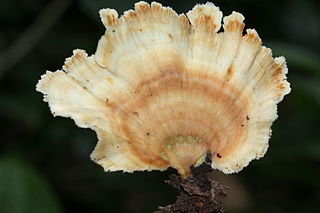
Flabellophora is a genus of poroid fungi in the family Steccherinaceae. The genus was circumscribed by New Zealand-based mycologist Gordon Herriot Cunningham 1965. Most species in the genus were described by E. J. H. Corner in 1987.
Laetifomes is a fungal genus in the family Polyporaceae. It is a monotypic genus, containing the single species Laetifomes flammans.

Stiptophyllum is a fungal genus in the family Polyporaceae. It is a monotypic genus, containing the single species Stiptophyllum erubescens. The genus was circumscribed by Norwegian mycologist Leif Ryvarden in 1973. Stiptophyllum erubescens is found in tropical South America and causes brown rot of wood. Its fruit body has a stipe, which distinguishes it from the similar genus Gloeophyllum.

Cyclophyllum is a genus of flowering plants in the family Rubiaceae. It is found from New Guinea, Australia and on islands in many parts of the Pacific.
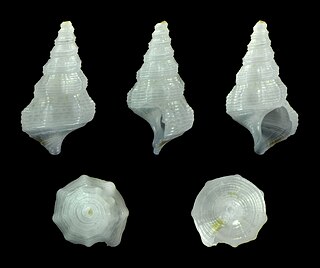
Cerithium protractum is a species of sea snail, a marine gastropod mollusk in the family Cerithiidae.
Calosoma bridgesi is a brachypterous species of ground beetle in the subfamily of Carabinae. The species is 18–20 millimetres (0.71–0.79 in), is reddish-black coloured, and is endemic to the Andes mountains of Bolivia, Argentina, and Chile where it is found on elevation of 3,500 metres (11,500 ft). It flies in January and February.
Calosoma macrum is a species of ground beetle in the subfamily Carabinae. It was described by John Lawrence LeConte in 1852. The species is 22–29 millimetres (0.87–1.14 in) long, black, and lives at an elevation of 1,100 to 1,700 metres in Guerrero, Mexico. It flies in June and October.
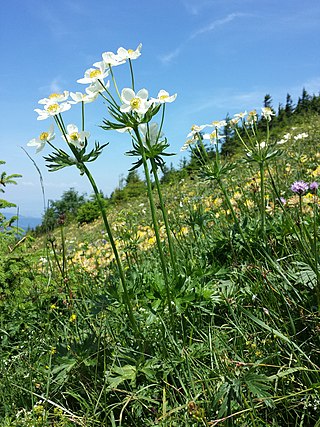
Anemonastrum is a genus of flowering plants in the family Ranunculaceae. Plants of the genus are native to the temperate and subarctic regions of North America, Greenland, Europe, Asia, South America, and New Zealand. The generic name Anemonastrum means "somewhat like anemone", a reference to the Anemone genus of closely related plants. It chiefly differs from Anemone in having a base chromosome number of x=7, as opposed to x=8.
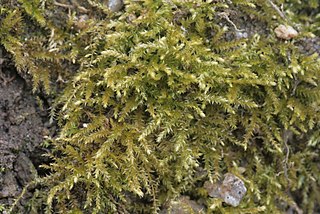
Oxyrrhynchium is a genus of mosses belonging to the family Brachytheciaceae. The genus has a cosmopolitan distribution.














